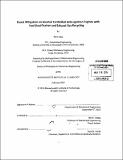| dc.contributor.advisor | Wai K. Cheng. | en_US |
| dc.contributor.author | Sang, Wen, Ph. D. Massachusetts Institute of Technology | en_US |
| dc.contributor.other | Massachusetts Institute of Technology. Department of Mechanical Engineering. | en_US |
| dc.date.accessioned | 2014-06-13T22:39:20Z | |
| dc.date.available | 2014-06-13T22:39:20Z | |
| dc.date.copyright | 2013 | en_US |
| dc.date.issued | 2014 | en_US |
| dc.identifier.uri | http://hdl.handle.net/1721.1/87981 | |
| dc.description | Thesis: Ph. D., Massachusetts Institute of Technology, Department of Mechanical Engineering, February 2014. | en_US |
| dc.description | "February 2014." Cataloged from PDF version of thesis. | en_US |
| dc.description | Includes bibliographical references (pages 184-186). | en_US |
| dc.description.abstract | This research is carried out to understand the mechanism of using fuel stratification and Exhaust Gas Recycling (EGR) for knock mitigation on boosted Controlled Auto-Ignition (CAl) engines. Experiments were first conducted on Rapid Compression Machine (RCM) to profile the ignition characteristic of the specific fuel used, and to explain the dilution effects of air and inert gas. Then the effect of fuel stratification and EGR were systematically examined on a production engine (modified 1.9 L Renault F9Q B800 common rail diesel engine) based test bench. The engine performance was interpreted with the auto-ignition fundamentals to sort out the intrinsic links among CAI engine knock propensity, engine operational parameters, and fuel stratification as well as EGR dilution extent. The nature of CAI engine knock, the metric of the phenomenon, and the theoretical rationales behind using fuel stratification and EGR for heat release control are reviewed before the experiment results are reported. RCM tests show that the sensitivity of fuel ignition delay to equivalence ratio varies with the ignition temperature, and higher sensitivity in the NTC region is preferred to make fuel stratification useful. With fixed fuel concentration, air dilution slightly reduces the ignition delay, while inert gas dilution could increase the ignition delay by a factor of 5. Inert gas dilution was found slowing down the fast heat release effectively for ignition temperature around NTC region. This indicates strong effect of EGR for CAI combustion knock mitigation. Engine tests demonstrates that fuel stratification has high potential for CAI knock mitigation, but its effect heavily depends on the extent of fuel stratification, engine configuration, and in-cylinder conditions. While 80% improvement on knock performance can be achieved with mid-compression stroke direct injection (DI), 400% higher knock intensity could also occur for late Dl. EGR was found effective in retarding combustion phasing and reducing knock intensity, attribute to its effect on both in-cylinder temperature control and heat release curbing, yet misfire could happen with too much EGR. With dual injections, the ratio of premixed fuel to directly injected fuel decreases the effect of fuel stratification in all aspects. Higher intake temperature deteriorates the knock performance. Higher engine speed retards the combustion phasing and enhances the fuel stratification extent and effect. Analysis shows that CAI knock tendency is largely determined by the in-cylinder temperature governed by combustion phasing, and many factors directly or indirectly influences the results. The primary effect of fuel stratification is on combustion phasing, although the heat release rate is also affected at the same combustion phasing. To better take advantage of fuel stratification and EGR for CAI knock mitigation, the engine operating parameters have to be in the right range. This research work could serve as a reference for future development of CAI engines with capability of knock free high load operations. | en_US |
| dc.description.statementofresponsibility | by Wen Sang. | en_US |
| dc.format.extent | 186 pages | en_US |
| dc.language.iso | eng | en_US |
| dc.publisher | Massachusetts Institute of Technology | en_US |
| dc.rights | M.I.T. theses are protected by copyright. They may be viewed from this source for any purpose, but reproduction or distribution in any format is prohibited without written permission. See provided URL for inquiries about permission. | en_US |
| dc.rights.uri | http://dspace.mit.edu/handle/1721.1/7582 | en_US |
| dc.subject | Mechanical Engineering. | en_US |
| dc.title | Knock mitigation on boosted Controlled Auto-Ignition engines with fuel stratification and Exhaust Gas Recycling | en_US |
| dc.title.alternative | Knock mitigation on boosted CAI engines with fuel stratification and EGR | en_US |
| dc.type | Thesis | en_US |
| dc.description.degree | Ph. D. | en_US |
| dc.contributor.department | Massachusetts Institute of Technology. Department of Mechanical Engineering | |
| dc.identifier.oclc | 880722876 | en_US |
